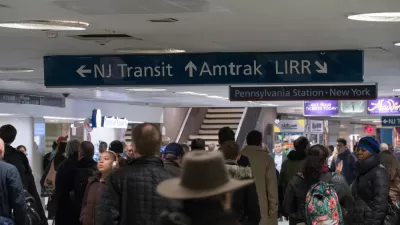The Republican campaign went back in time last week. Not to the 1950s Red Scare, to the 1844 Nativist Riots, or to the Great Awakening of the 1740s—though it had elements of all of those. It went back to the 1970s. And it went back to a specific place: the Bronx.
It was in the decade of disco that the Bronx descended into one of the worst epidemics of violence and urban decay that the United States has ever seen. It was the culmination of
white flight, corporate flight, disinvestment, racist lending practices, overzealous policing, drug criminalization, poor education,
lead poisoning, and so many other negligences and offenses that left the borough in ashes and left so many other cities in similar states of decay.
At the same moment that the Bronx was burning, a borough and a world away, a young Donald Trump was plotting his first business deals. His father was reportedly evicting African-Americans from his properties in Queens. Whether their crimes will prove greater than the theft and looting of his fellow New Yorkers will be for history to judge.
In 1975, Gerald Ford proverbially told
New York City to drop dead. Last week, after four decades of progress Donald Trump tried to bury it again.
In his
acceptance speech at the Republication National Convention, Trump cited a litany of urban horrors that have supposedly festered in the past eight years:
- "Violence in our streets and the chaos in our communities"
- "Crime, terrorism, and lawlessness that threatens our communities"
- "Homicides last year increased by 17% in America's fifty largest cities. That's the largest increase in 25 years."
- "In our nation's capital, killings have risen by 50 percent. They are up nearly 60 percent in nearby Baltimore."
- "In the president's hometown of Chicago, more than 2,000 have been the victims of shootings this year alone. And almost 4,000 have been killed in the Chicago area since he took office."
- "Our roads and bridges are falling apart, our airports are in third world condition"
Claims and statistics like these are rightfully chilling. Every violent crime that takes place on America’s streets is an affront to our culture and our national spirit. One murder in Chicago, Baltimore, or anywhere else, is one murder too many. Especially when it’s committed by a police officer against an innocent citizen. Especially when it’s committed by a citizen against an innocent police officer. Especially when it’s committed with weapons that should have never have been on the streets in the first place.
And yet, for the all the intimate horrors of individual crimes, Trump’s carefully chosen statistics—not necessarily false, but certainly incomplete—belie the astonishing progress that America's cities have made.
Justice department
data indicate that "the U.S. homicide rate declined by nearly half (49%), from 9.3 homicides per 100,000 U.S. residents in 1992 to 4.7 in 2011, falling to the lowest level since 1963." That trend
continued through 2014, meaning that the 17 percent increase that Trump cites is minuscule, in absolute numbers, compared to the averages that prevailed decades ago.
Four-hundred-eighty-eight people were killed in Chicago last year. You'd have to go back to the Kennedy administration to find a year with significantly fewer murders (granted, Chicago’s population was greater in the 1960s than it is today). In 1983, the year the Trump Tower was completed, New York City had 1622 homicides. Last year: 352. That’s a triumph by any measure. Surely someone deserves credit for it?
In short: violent crime in American has dropped—steadily and dramatically—for Donald Trump's entire adult life.
He and every other American politician has good reason, of course, to point to the dramatic, tragic examples of Orlando, San Bernardino, and Dallas. But they represent a different kind of danger, demanding different kinds of responses, than the broad criminal trends that Trump attempts to cite.
And that refrain about "law and order." When you think of "law and order," you don’t think of suburbs or Main Street. You think of the inner city. You think of batons and water cannons and curfews. You think of militaristic posturing that can be more scary to city residents than crime itself.
Trump can get away with these distortions because he's not trying to appeal to urbanites in the first place. He's not standing in solidarity with the good citizens of Chicago, New York, and Baltimore. Bafflingly, his electorate has made its disdain for "New York elitism" well known. He's creating an image of inner cities that enables the citizens (good and bad) of suburbia and the rural heartland to believe in their own worst visions of the city. These visions may have been semi-legitimate reasons for middle class families to flee cities in the 1960s and 1970s. Today, they are fabrications meant only to support their lifestyle choice at the expense of all things bustling and cosmopolitan.
In other words, Trump wants the threat of urban violence to motivate voters who have the least to fear from it.
This would all be typical right-wing pandering were it not so ironic. Donald Trump is a proud, lifelong resident of New York City. He made his fortune there. He pins his identity to it. He has contributed to it, and he has literally put his name on its skyline—multiple times.
Of course, Trump knows what he's doing. If you want to make a fortune, raise your standard of living, enjoy diversity, and rub elbows with humanity—sometimes for worse, but overwhelmingly for better—there is no better place to go than New York City. And if you want to drive a national economy, there is no better engine than New York City.
The metropolitan area's GDP is north of $1.5 trillion, making it the second-wealthiest urban area in the world, after Tokyo. (
Los Angeles is a distant third, at $866 billion.) It's 6 percent of the U.S. population but 8 percent of the country's GDP. That doesn't count the economic activity generated by activities in New York City but that takes place elsewhere. These are the forces that make the Trump Tower worth many times more than it was when it was completed in 1983.
Indeed, one thing that would make his—and all other urban properties—more valuable would be, as Trump's speech notes, the repair of America's infrastructure. That's a multitrillion-dollar project that the (Republican-led) Congress has scarcely touched and that this year's Republican
platform neglects yet again.
Of course, none of this is surprising. Despite the need for a coherent, positive urban policy (here’s a nice one from
Grist), the federal government, regardless of party leadership, has neglected cities for a great long while. Cities have been dead to the Republican Party for a long time. Trump’s rhetoric only makes them—and their inhabitants—seem more forbidding than ever.
And yet, America's cities persevere. Imagine how great they would be if, after weathering so many years of neglect, derision, crime, and, yes, disco, they got the respect, and the national leaders, they deserve.


































